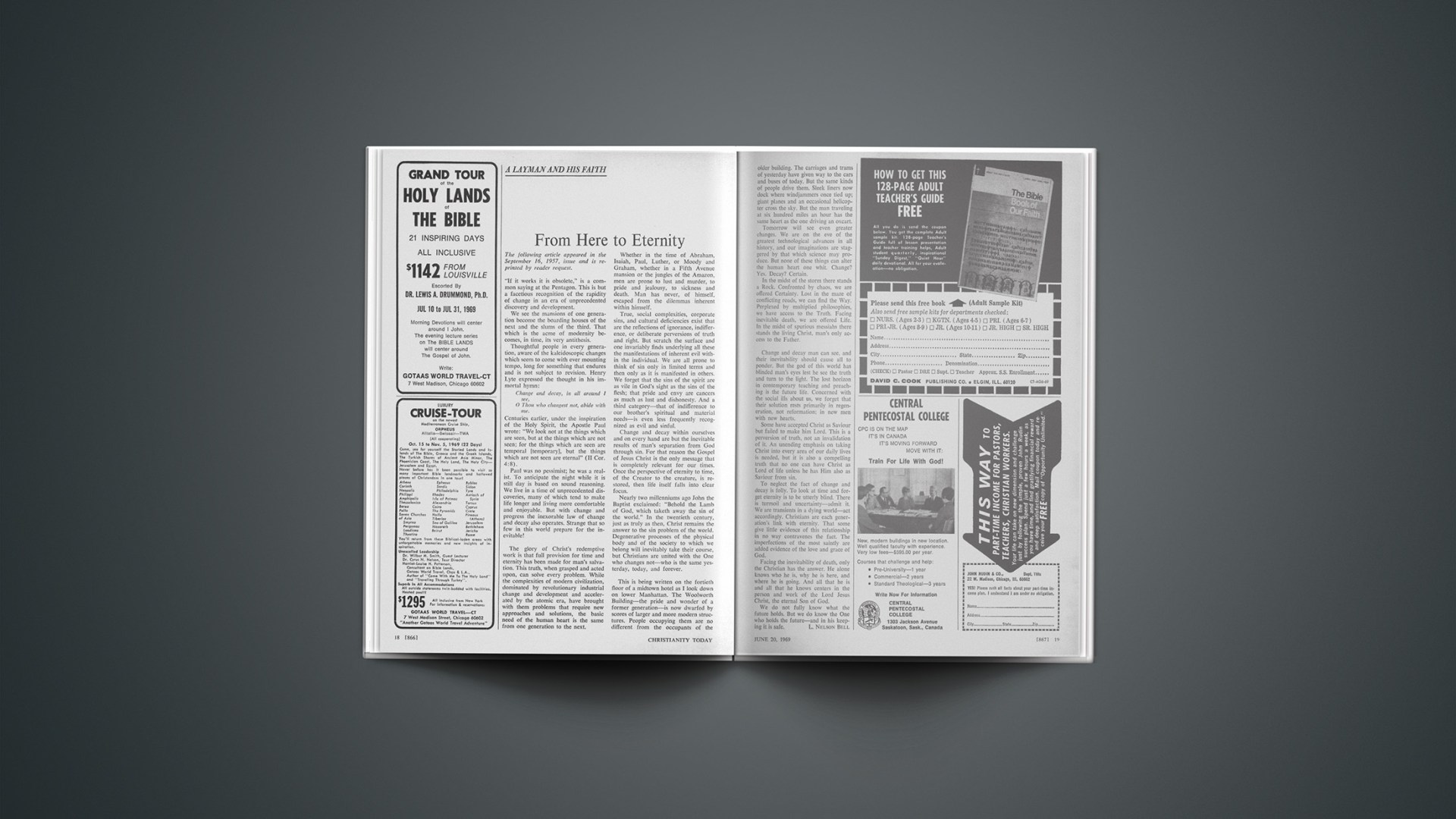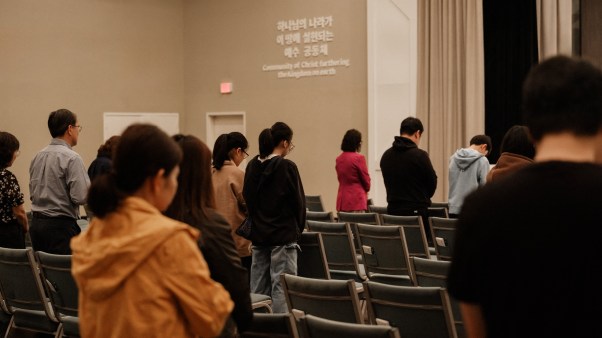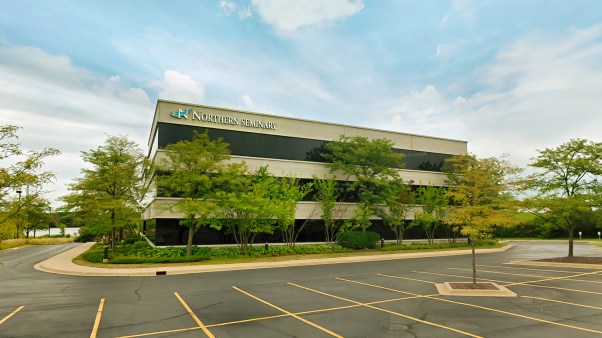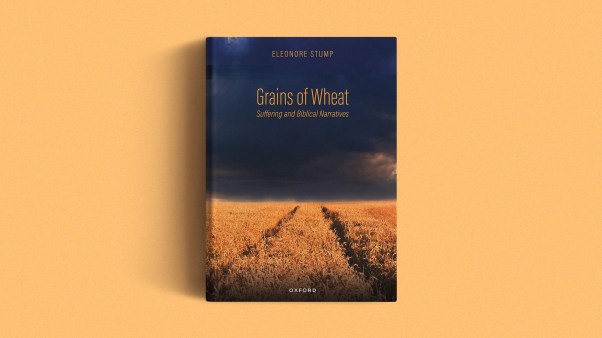The following article appeared in the September 16, 1957, issue and is reprinted by reader request.
“If it works it is obsolete,” is a common saying at the Pentagon. This is but a facetious recognition of the rapidity of change in an era of unprecedented discovery and development.
We see the mansions of one generation become the boarding houses of the next and the slums of the third. That which is the acme of modernity becomes, in time, its very antithesis.
Thoughtful people in every generation, aware of the kaleidoscopic changes which seem to come with ever mounting tempo, long for something that endures and is not subject to revision. Henry Lyte expressed the thought in his immortal hymn:
Change and decay, in all around I see,
O Thou who changest not, abide with me.
Centuries earlier, under the inspiration of the Holy Spirit, the Apostle Paul wrote: “We look not at the things which are seen, but at tire things which are not seen; for the things which are seen are temporal [temporary], but the things which are not seen are eternal” (2 Cor. 4:8).
Paul was no pessimist; he was a realist. To anticipate the night while it is still day is based on sound reasoning. We live in a time of unprecedented discoveries, many of which tend to make life longer and living more comfortable and enjoyable. But with change and progress the inexorable law of change and decay also operates. Strange that so few in this world prepare for the inevitable!
The glory of Christ’s redemptive work is that full provision for time and eternity has been made for man’s salvation. This truth, when grasped and acted upon, can solve every problem. While the complexities of modern civilization, dominated by revolutionary industrial change and development and accelerated by the atomic era, have brought with them problems that require new approaches and solutions, the basic need of the human heart is the same from one generation to the next.
Whether in the time of Abraham, Isaiah, Paul, Luther, or Moody and Graham, whether in a Fifth Avenue mansion or the jungles of the Amazon, men are prone to lust and murder, to pride and jealousy, to sickness and death. Man has never, of himself, escaped from the dilemmas inherent within himself.
True, social complexities, corporate sins, and cultural deficiencies exist that are the reflections of ignorance, indifference, or deliberate perversions of truth and right. But scratch the surface and one invariably finds underlying all these the manifestations of inherent evil within the individual. We are all prone to think of sin only in limited terms and then only as it is manifested in others. We forget that the sins of the spirit are as vile in God’s sight as the sins of the flesh; that pride and envy are cancers as much as lust and dishonesty. And a third category—that of indifference to our brother’s spiritual and material needs—is even less frequently recognized as evil and sinful.
Change and decay within ourselves and on every hand are but the inevitable results of man’s separation from God through sin. For that reason the Gospel of Jesus Christ is the only message that is completely relevant for our times. Once the perspective of eternity to time, of the Creator to the creature, is restored, then life itself falls into clear focus.
Nearly two millenniums ago John the Baptist exclaimed: “Behold the Lamb of God, which taketh away the sin of the world.” In the twentieth century, just as truly as then, Christ remains the answer to the sin problem of the world. Degenerative processes of the physical body and of the society to which we belong will inevitably take their course, but Christians are united with the One who changes not—who is the same yesterday, today, and forever.
This is being written on the fortieth floor of a midtown hotel as I look down on lower Manhattan. The Woolworth Building—the pride and wonder of a former generation—is now dwarfed by scores of larger and more modern structures. People occupying them are no different from the occupants of the older building. The carriages and trams of yesterday have given way to the cars and buses of today. But the same kinds of people drive them. Sleek liners now dock where windjammers once tied up; giant planes and an occasional helicopter cross the sky. But the man traveling at six hundred miles an hour has the same heart as the one driving an oxcart.
Tomorrow will see even greater changes. We are on the eve of the greatest technological advances in all history, and our imaginations are staggered by that which science may produce. But none of these things can alter the human heart one whit. Change? Yes. Decay? Certain.
In the midst of the storm there stands a Rock. Confronted by chaos, we are offered Certainty. Lost in the maze of conflicting roads, we can find the Way. Perplexed by multiplied philosophies, we have access to the Truth. Facing inevitable death, we are offered Life. In the midst of spurious messiahs there stands the living Christ, man’s only access to the Father.
Change and decay man can see, and their inevitability should cause all to ponder. But the god of this world has blinded man’s eyes lest he see the truth and turn to the light. The lost horizon in contemporary teaching and preaching is the future life. Concerned with the social ills about us, we forget that their solution rests primarily in regeneration, not reformation: in new men with new hearts.
Some have accepted Christ as Saviour but failed to make him Lord. This is a perversion of truth, not an invalidation of it. An unending emphasis on taking Christ into every area of our daily lives is needed, but it is also a compelling truth that no one can have Christ as Lord of life unless he has Him also as Saviour from sin.
To neglect the fact of change and decay is folly. To look at time and forget eternity is to be utterly blind. There is turmoil and uncertainty—admit it. We are transients in a dying world—act accordingly. Christians are each generation’s link with eternity. That some give little evidence of this relationship in no way contravenes the fact. The imperfections of the most saintly are added evidence of the love and grace of God.
Facing the inevitability of death, only the Christian has the answer. He alone knows who he is, why he is here, and where he is going. And all that he is and all that he knows centers in the person and work of the Lord Jesus Christ, the eternal Son of God.
We do not fully know what the future holds. But we do know the One who holds the future—and in his keeping it is safe.
L. NELSON BELL










